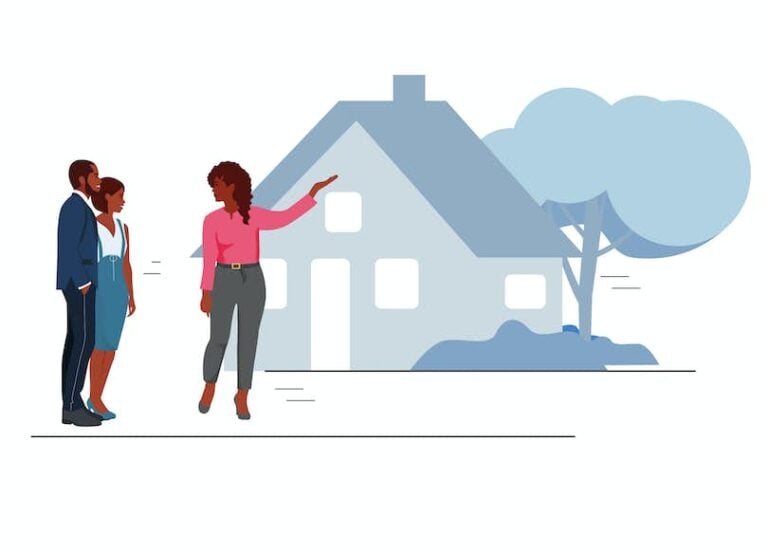Do you need an appraisal? | How do appraisals work? | What appraisers look for | After the appraisal | Frequently asked questions
A property appraisal is a professional estimation of a home's value, usually based on a physical inspection and recent comparable home sales in the area.
Lenders require appraisals as part of the approval process for most home purchase and refinance loans.
The appraisal process usually takes about one to two weeks in total, from the initial order to the report submission.
If the appraised value of a home is lower than expected, the lender may adjust the amount of your loan or deny the applicant outright. This can delay a transaction or, in some cases, result in it falling through entirely.
Standard home appraisals usually cost $250 to $500 dollars[1] and are paid for by the loan applicant — the buyer in a home purchase, or the homeowner when refinancing.
If you're not yet at the point where you need an appraisal and just want to know what your house may get on the open market, you can use our free online home value estimator below.
Discover the true value of your home with our Home Value Estimator!
Situations that usually require an appraisal
While appraisals are only legally required in specific situations,[2] almost all lenders require them in the loan approval process. Chances are you'll need to get an appraisal if you're:
-
Purchasing a home with a loan, whether conventional or government backed, to ensure the home is worth the agreed-upon purchase price
-
Refinancing an existing loan to verify the amount of equity you have in your home and set the terms of the refinance loan
- Giving or receiving a "gift of equity," when a home is transferred for less than its actual market value — between family members, for example
🏠 Optional: Pre-listing appraisals for home sellers
Some home sellers — particularly those with high-end properties or those selling without an agent — will get an appraisal before listing their home to help set the price.
Pre-listing appraisals aren't required and are paid for by the seller. If they go under contract with a buyer using a home purchase loan, chances are the buyer will still get their own appraisal as part of their mortgage approval process.
Why do most lenders require appraisals?
Appraisals offer lenders some degree of financial protection, so they don't loan out more than a property is actually worth. This helps ensure the bank will be able to recoup its money if it ends up having to foreclose upon and resell the property.
Situations that may NOT require an appraisal
An appraisal may be optional or avoidable if you're:
-
Making an all-cash purchase. Because no lender is involved, getting an appraisal is entirely up to you. That said, it's usually a good idea to protect your investment and verify the price is fair.
-
Recently appraised homes. If the lender already has a recent appraisal on the books — typically within the past 120 days — they might not require a second appraisal.
-
Refinancing with certain types of government-backed refinancing loans, such as:
💡 What are appraisal waivers and how do I get one?
Appraisal waivers allow eligible borrowers to skip the appraisal during the purchase or refinance loan-approval process. Getting an appraisal waiver is often easier said than done, however, as the eligibility requirements are strict.
How does the appraisal process work when buying a home?
Step-by-step | Finding an appraiser | Who pays, and how much? | During the appraisal | Remote appraisals
If you’re buying a home, you must have an accepted offer and signed contract before the approval process — which includes the home appraisal — can actually begin.
Appraisals typically take about one to two weeks from the date of the inspection to the submission of the report. The process can take longer in areas with high demand (i.e., many homes being sold) and relatively few appraisers.
An appraisal report is typically good for 120 days. So if you got an appraisal but your closing was delayed by several months, you would probably need a second appraisal before closing.
Step-by-step overview of the appraisal process
-
The lender orders the appraisal after an offer has been accepted and the purchase contract signed. Appraisals usually take place after the home inspection.
-
The appraiser visits and inspect the home, after coordinating with the seller and real estate agents (though nowadays this sometimes happens remotely).
-
The appraiser drafts the report and submits it to the lender. This can take several days or a few weeks.
- The lender reviews the report, finalizes your loan terms, and sends a closing disclosure detailing your loan terms and closing costs.
How does the lender choose an appraiser?
How lenders can hire and interact with appraisers throughout a transaction is governed by a long list of rules and regulations:[3]
-
Appraisers must be licensed or certified, independent, and objective.
-
Loan officers and brokers cannot select the appraiser (neither can the borrower).
-
Lenders can not discuss or convey a "target value" at the time of assignment.
Though not technically required, many lenders will order appraisals through a third-party appraisal management company to avoid any potential regulatory complications.
Some lenders have direct referral relationships with independent appraisers in their area. Others may have their own, internal appraiser branches, which are legal to use so long as they operates 100% independently from the loan production of the business.[4]
Who pays for the appraisal and how much do appraisals cost?
In almost all cases, the borrower — either the home buyer or refinancer — pays for the appraisal. A standard home appraisal is about $350 on average.
Appraisals for government-backed loans (FHA, USDA, VA) are more in-depth and stringent, which usually makes them slightly more expensive. FHA and USDA loans cost about $50 to $100 more than regular appraisals. Appraisals for VA loans are governed by the VA, and those fees vary by state.
Appraisals can cost more or less depending on the home and market rates. Homes in high cost-of-living areas cost more, as do complex properties — like huge mansions and homes with water frontage.
What happens during an appraisal inspection?
A traditional "full" appraisal involves an appraiser visiting the house — usually for about 30 to 60 minutes — and visually inspecting the interior and exterior of the home.
The appraiser evaluates the home's overall condition and physical features and takes photos, measurements, and notes.
» LEARN: What appraisers look for
The seller's agent will often attend the appraisal inspection; sometimes the buyer's agent will as well. Buyers and sellers themselves usually don't go to the appraisal.
After the on-site inspection, the appraiser goes back to the office to crunch the numbers and cross-reference the data with the prices of recently sold comparable homes ("comps") in the area.
The appraiser uses all of this information to arrive at an objective estimation of the home's fair market value, which they then submit to the lender.
Throughout the process, appraisers are expected to follow a set of consistent principles and code of ethics known as the Uniform Standards of Professional Appraisal Practice (USPAP).[5]
These rules and protocols have been adopted by Congress and are enforced on a state level. Many appraiser associations and lenders enforce these standards as well.
| 🕵 Home appraisal vs. home inspection
People often mix up appraisals and inspections, but they're actually separate processes, conducted by different professionals, with distinct outcomes.
» MORE: How Long Does a Home Inspection Take & What Happens Next? |
Fully and partially remote home appraisals are becoming more common
Appraisers don't always go on-site, especially in light of improved technology and COVID-19 safety precautions.
Three common alternative types of appraisals
-
Hybrid: The appraiser analyzes data remotely while someone else — like an agent, trainee appraiser, or home inspector — performs the in-person inspection.
-
Desktop: The appraiser estimates the market value at their desk, referencing the MLS, tax, and comparative sales data.
-
Drive-by: The appraiser drives by the house, checks out the exterior and the neighborhood, then does a desktop appraisal.
Whether you're purchasing or refinancing, you typically won't have a say in what type of appraisal you get. Remote appraisals can sometimes be less accurate, but they're usually less expensive.
What appraisers look for when inspecting a home
To estimate a home's value, appraisers largely rely on recent sale prices for comparable properties in the same market.
When looking at a home, appraisers consider a variety of factors to determine which local properties are actually "comparable" — and how the property in question measures up, adding or subtracting value based on relative quality and desirability. These factors include:
-
Innate aspects of the property. Location and neighborhood characteristics, zoning classification, lot size, public utilities, and natural amenities
-
Exterior characteristics. Style and architecture of the home, quality of construction materials, condition of key facets (e.g., siding, roof, foundation), and exterior amenities (e.g., decks, porches, pool, outbuildings, landscaping)
-
Interior characteristics. Square footage, number of beds and baths (and their sizes), general layout, age and condition of appliances and mechanical systems, upgrades, and renovations
Appraisers are generally looking for any signs of major defects or wear and tear. While something like a messy house or unmowed lawn shouldn't technically influence the assessment, appraisers are people and they might be influenced by unkempt properties.
|
💡 FHA and VA loan appraisals have a long list of requirements Government-backed loans have stricter rules and regulations during the approval process, which can sometimes lead to longer turnaround times and higher appraisal fees. For example, FHA and VA lenders require homes to have:
You can check out the full list of HUD appraisal requirements here. |
What happens after the appraisal?
Value comes in high | Value comes in low | Options for dealing with a low appraisal | Requesting a reconsideration of value
After the appraiser conducts the inspection and prepares the report, they'll submit it to the lender. Total turnaround time for an appraisal takes anywhere from a few days to a couple of weeks.
The lender will look at the appraised value of the home, plus your loan application and financial profile, to determine the final amount and terms of your loan.
What if the appraisal comes in higher than the contract price?
In a home purchase, if the appraisal comes in higher than that contracted sale price, the simple answer is that the buyer got themselves a good deal.
Unless you agree to it, the seller cannot retroactively raise the sale price in light of a higher appraised value because that would be a breach of contract. The mortgage amount stays the same because the sale price doesn’t actually change.
What if the appraisal comes in low?
If the appraisal comes in lower than the purchase price, your lender will likely decrease the amount you can borrow — or even deny the loan application.
For example, if you were buying a home for $400,000 with a 20% down payment, that translates to a:
-
$320,000 mortgage
-
$80,000 down payment
Here, the loan to value ratio (LTV) — the size of the mortgage relative to the home's appraised value — is 80%. That's considered "safe" by most lenders.
But if the appraisal comes back at $375,000 instead of the $400,000 sale price, the bank now only wants to lend 80% of the appraised value — in this case, 80% of $375,000, which is $300,000. So your max loan amount drops from $320,000 to $300,000, creating a difference of $20,000.
Your options when an appraisal comes in low
Option 1: Come up with a bigger down payment
As the buyer, you can bring more cash and cover the $20,000 difference needed to hit the full $400,000 sale price now that the max loan amount has dropped. That's on top of the original $80,000 down, bringing the new total down payment to $100,000.
Option 2: You renegotiate the sale price with the seller
If you're unwilling or unable to cover the gap, you can try to negotiate with the seller to drop the sale price to the appraised $375,000 — or at least low enough so you can actually afford to cover the difference.
Option 3: Walk away
If the deal is no longer affordable, you can simply walk away. If you have an appraisal contingency in your purchase agreement, you can pull out of the deal without penalty. If not, you can still walk away, but you may lose your earnest money deposit.
What can you do when you think an appraisal is wrong?
Appraisers can and do make mistakes! If you see any obvious errors or omissions in the report that you think may have resulted in an incorrect appraised value, you can dispute the findings by requesting a reconsideration of value (ROV).
| ✍️ Editor's note: Bias in home appraisals
A new report from Freddie Mac has confirmed that Black and Latinx homeowners may experience an appraisal gap. That means their homes are undervalued (appraised at a lower value than the final sale price) more frequently than those of white homeowners. In majority-Black neighborhoods, up to 12.5% of properties were undervalued. In majority-Latinx neighborhoods, up to 15.4% of properties were undervalued. Only 7.4% of appraisals in majority-white communities were lower than the eventual contract price. If you believe you've been a victim of appraisal bias, you can file a complaint and request an ROV. See HUD's Fair Lending guidelines for more information. |
Things you can include in an ROV
-
Up to three recent comparable sales that suggest a different market value
-
A second appraisal report on subject property as evidence of inaccuracy
-
A list of significant errors or omissions from the initial report, specifically citing physical aspects of the home or overlooked comparable sales
Things not to include in an ROV
-
Personal property, like furniture or above-ground pools
-
Sales data for non-similar homes (i.e., homes that don't qualify as comparable)
-
Active or not-yet-sold listings
-
Non-verifiable data like a realtor's opinion or automated online valuations (e.g., Zillow's Zestimates)
If you think the appraiser obviously got it wrong, it's certainly worth contesting — but note that these rebuttals aren't guaranteed to work. Your real estate agent will likely be able to advise on the best course of action for your situation.
If you're weighing your options for buying or selling a house, Clever can help!
Our fully licensed concierge team can answer your questions and provide objective advice on getting the best outcome with your sale or purchase.
When you enter your info below, we'll ask you a few questions about your situation via a short form. Then our concierge team will be in touch shortly to help.
This service is free, and there’s never any obligation to move forward with us.
Related articles
FAQs
Do I need an appraisal?
Probably, if you're applying for a home purchase or refinancing loan. Most lenders require appraisals as part of the loan application process to verify the home's fair market value and protect themselves from lending out too much. You don't need an appraisal if you're a cash buyer.
How long does an appraisal take?
A standard, on-site home appraisal typically takes 30–60 minutes; it can take several hours for larger, more complicated properties. It usually takes up to two weeks to finalize and submit.
How soon can I close after an appraisal report comes in?
Every loan is different, so it depends on when underwriting is finished and the loan is approved. However, you can likely close within about two weeks after the appraisal report is submitted. Appraisals are usually good for 120 days — beyond that, your lender will likely want another appraisal.
How do home appraisals work?
A lender orders an appraisal after an offer has been accepted and the purchase contract signed. An appraiser visits the home and evaluates its overall condition and physical features, then estimates its value based on comparable sales data. They'll submit that report to the lender, who finalizes your loan terms.




